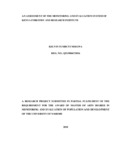| dc.description.abstract | According to the KEFRI strategic plan weak monitoring and evaluation system was
highlighted as one of the weaknesses of the organisation. Therefore, the purpose of this
study was to; establish if there are structures for people, partnership and planning for
KEFRI M&E system, review mechanisms for data management processes at KEFRI and
establish if there is evidence of dissemination and use of data from the KEFRI M&E
system in decision making. The assessment of this M&E System adopted the 12
components that were interrelated and which are divided into three categories. The study
employed a descriptive case study design to assess the M&E Systems of KEFRI. This
study utilized a purposive sampling approach. Data was collected through administering
of questionnaires. Each of the 12 components was analyzed independently based on the
performance of their respective elements identified and an average of each obtained to
determine the total system performance. After the assessment KEFRI had an average
score of 68 percentage. The Costed work plan component scored the highest at 84 percent
while data demand and use attained the lowest score at 52 percent. The key strengths of
KEFRI M&E system include: strong M&E partnerships, costed work plans, continuous
communication and advocacy to improve programme. Key gaps that were identified
include: inadequate staff with the required knowledge and skills in M&E, documentation
of M&E procedures, inadequate evaluation and research capacity of M&E staff,
corrections are not made after data quality assessments. The recommendations made were
that to have a fully functional M&E systems, program and M&E managers should ensure
that their M&E system meet the conventional M&E system requirements. Further, they
should avail frameworks to support M&E systems; through employing M&E systems’
quality management practices and providing structures for assessing the crucial M&E
system components as prescribed by Monitoring and Evaluation Reference Group
(MERG). | en_US |



